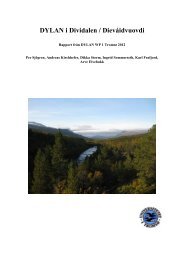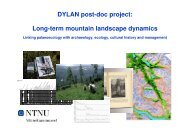Guide to identification of Lumbrineridae (Polychaeta) - NTNU
Guide to identification of Lumbrineridae (Polychaeta) - NTNU
Guide to identification of Lumbrineridae (Polychaeta) - NTNU
You also want an ePaper? Increase the reach of your titles
YUMPU automatically turns print PDFs into web optimized ePapers that Google loves.
<strong>Lumbrineridae</strong> in Norwegian and adjacent waters 6<br />
Key <strong>to</strong> genera<br />
1. Composite or pseudocomposite hooded hooks present in anterior part <strong>of</strong> body....................... 2<br />
- All hooded hooks simple, anterior body may have limbate chaetae only …............................. 4<br />
2. Mx IV forming a squarish plate with whitish central area and black margins. Mx V absent.<br />
Occipital antennae may be present at posterior border <strong>of</strong> pros<strong>to</strong>mium …................ Augeneria<br />
- Mx IV a triangular <strong>to</strong> oblong evenly black or brown plate with a marked <strong>to</strong>oth. Mx V present,<br />
rounded ………………………………………………………………………………………. 3<br />
3. Mx II almost as long as mx I (about 2/3 or 3/4 <strong>of</strong> the length), connected <strong>to</strong> mx I with narrow <strong>to</strong><br />
moderately wide connecting ligament. Aciculae pale, brown or black .................. Lumbrineris<br />
- Mx II about half as long as mx I, connected <strong>to</strong> mx I by wide connecting ligament. Aciculae<br />
yellow …………………………………………………………………………..…. Hilbigneris





